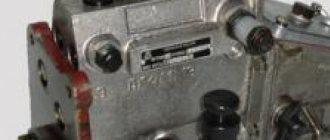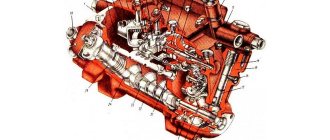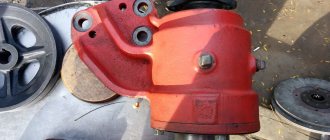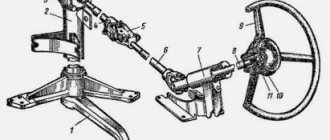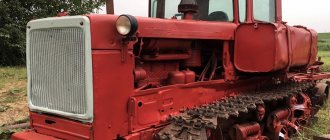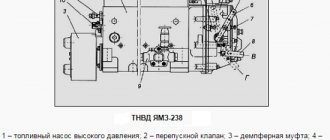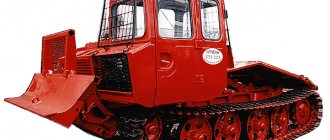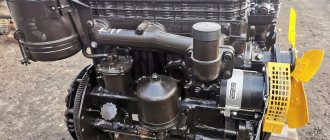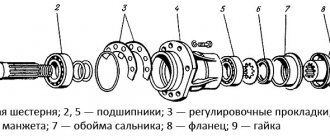The cleanliness of the oil in an internal combustion engine is important. The absence of foreign inclusions in the oil ensures optimal lubrication and preservation of the service life of the rubbing surfaces in the joints of the piston group parts and the crank mechanism. The lubrication system of the D-240 diesel engine and its modifications of MTZ tractors includes a centrifuge. The function of the unit is to clean the circulating oil in the engine system from contaminants, and the name itself speaks of the centrifugal principle of operation.
Low pressure.
Questions can only be asked after registration.
Please login or register. What could be the reason for low pressure on a hot engine? D-240 engine, when I start it, it shows 300-350 kPa, it heats up to 80, the pressure drops to 100 kPa. on the old unit, when hot, it did not drop below 250, I changed the unit and the same problem began
There are many reasons, oil pump, liner-crankshaft gaps, tightening the drain valve on the centrifuge will not help, change the oil pump
choosing from these reasons, I already tightened the valve, changed the liners and the crankshaft 2 years ago (I didn’t have to separate the crankshaft. I’ll have to change the oil pump. But could it depend on the oily radiator?
choosing from these reasons, I already tightened the valve, changed the liners and the crankshaft 2 years ago (I didn’t have to separate the crankshaft. I’ll have to change the oil pump. But could it depend on the oily radiator?
Yes, the gaps are fine, I changed the liners. I just had an old block and the fist showed on it, I changed the block and the pressure became low
What could be the reason for low pressure on a hot engine? D-240 engine, when I start it, it shows 300-350 kPa, it heats up to 80, the pressure drops to 100 kPa. on the old unit, when hot, it did not drop below 250, I changed the unit and the same problem began
I worked on the tractor for almost 30 years, but recently I encountered a drop in pressure, I ground the crankshaft a year ago at home, a mechanic I know measured the shaft journals and said it was bored out perfectly for cold 4 and for hot 1 pressure, I ground the valves in a tsintrafuge, tightened the pressure reducing valve to the end, replaced it with a new oil pump the result did not change, changed the oil with high viscosity to cold, began to press 5 to hot 1.5. I already wanted to remove the engine but decided to check the centrifuge again, unscrewed the tube that goes to the sensor in the cabin, connected the compressor to the fitting and, under pressure, checked the tightness of the centrifuge, here it was REASON FOR LOW PRESSURE Oil was flowing from under the rotor cap in all directions, it turns out that the sealing rubber ring was worn out, I changed it to a new one and the result on a cold engine at low speeds showed 5.5, warmed up to eighty 5, adjusted the valve, now it doesn’t drop below 3. And I almost disassembled the engine, check the centrifuge and the tube on the rotor that goes into the body of the centrifuge must fit tightly. This is the exact story that happened, live and learn.
Only those who do nothing make no mistakes
Source
How to check the oil pump of an MTZ engine
You can check the oil pump without removing it, which will allow you to quickly obtain basic information about the condition of the unit. Let's look at the basic steps for diagnostics without dismantling.
- Checking the pressure in the system.
Sometimes the oil pressure light does not work correctly and lights up even when the readings are normal. You can check the oil pump by installing a pressure gauge instead of the hazard warning light sensor.
You need to check the pressure when it is hot.
- Checking and cleaning the oil receiver mesh and filter.
You can check whether the filters are clogged without dismantling the oil pump. Their clogging is a common cause of malfunctions in the cooling system. Particular attention should be paid to the oil receiver mesh - it gets clogged most often.
Centrifuge MTZ-80: device
On diesel D - 240
a new active-reactive centrifuge was used. Unlike a reactive one, it does not have nozzles.
All oil entering the rotor is supplied to the main oil line.
8
is fixedly attached to axis 9 , having channels
A
tangent to its circumference.
Centrifuge operation diagram
At the top of the body 7
The rotor has tangentially located channels.
B.
_
Unrefined oil under pressure enters through the annular cavity B
(between the axle and the tube) into
channels
A. Flowing out of these channels under pressure, the oil jets form an active torque, which causes the rotor to rotate in the direction of the jet movement, as shown in Figure 4
.
The purified oil is ejected at high speed through channels B
in the upper part of the rotor and enters the stationary axis channel and then into the oil line. In this case, a reactive force arises, which also rotates the rotor. Thus, the centrifuge rotor rotates due to the total energy of two oil flows: active and reactive.
Diesel centrifuge D-240
The rotor consists of a housing 16
(Fig. 6) and glasses
17
.
The area of the upper bottom is larger than the area of the bottom. The total oil pressure force directed upward is greater than the force acting on the bottom of the rotor. As a result, when the engine is running, the rotor floats up and unloads the supporting end. The rotor is kept from moving upward by a thrust washer 18
, and downwards by the shoulder of the axle
13
.
Axial run - 0.3...1.5 mm. There are three valves installed in the filter housing: bypass 12
, drain
8
, and radiator
4
.
Bypass valve
(
12
) maintains oil pressure in the rotor.
If at the entrance to the rotor it rises to 0.65 MPa (with thick oil or a dirty rotor), the valve opens and the unrefined oil is drained into the engine crankcase. For some engines, the oil is transferred to the main oil line, bypassing the centrifuge. The bypass valve is adjusted with screw 10
to a pressure of 0.65…0.70 MPa.
Radiator valve
(
4
) is necessary to bypass cold oil, bypassing the oil cooler into the engine oil channels. Radiator valve is not adjustable
Drain valve 8 is designed to drain excess purified oil into the crankcase when the pressure in the channels increases. The valve is adjusted with screw 10 to normal oil pressure in the system.
The design of these valves is identical to that of the oil pump valves.
Lubrication system of the MTZ-82 (MTZ-80) tractor
The engine of the MTZ-82 (MTZ-80) tractor uses a combined lubrication system: one part of the parts is lubricated under pressure, the other - by splashing oil.
The engine cylinder block has a longitudinal oil channel, from which oil is supplied through transverse channels to each main bearing and to all camshaft journals.
The crankshaft and camshaft bearings, the idler bushing and the fuel pump drive gear, as well as the valve train, are lubricated under pressure from the gear oil pump.
Liners, pistons, piston pins, camshaft cams, and pump drive are splash lubricated.
Rice. 20. Centrifugal oil filter:
1 — rotor axis; 2 — centrifugal filter housing; 3 - nozzles; 4 — locking screw; 5 - tube; 5 — rotor housing; 7 — inner glass; 8 — rotor housing cover; 9 — stacked rotor; 10 — special nut; 11 — sealing ring; 12 — thrust washer; 13 — nut; 14 — centrifugal filter cap; 15 - ring; 16 — cap nut; 17 — washer; 18 — safety valve; 19 — drain valve: 20 — radiator valve (reducing); 21 - screw; 22 — tangential holes; 23 - radial holes.
General lubrication instructions
Depending on the ambient temperature, use oils of different viscosities according to this manual. The physical and chemical properties of the oils used must correspond to those indicated in the table “Oils and lubricants used for Belarus tractors.”
Engine D240 - Technical characteristics and engine size
Technical characteristics of the car Lada (VAZ) 21703 (priora) (2007(2013)). Lada 217030 technical specifications
Since 1974, the MTZ 80 universal wheeled tractor has rolled off the assembly line of the Minsk Tractor Plant. The design allows the machine to be used in the following areas: agriculture, construction, and housing. Among wheeled tractors, the model is widespread, since the number of produced equipment exceeds its competitors.
The reason for the popularity of the technical tool is the use of a reliable and at the same time simple power plant, the role of which was played by the D240 engine. The design of the unit is simple, does not require complex maintenance conditions, and is used in temperature ranges of both southern and northern latitudes. In addition, the reasonable price of the engine and the installation of an assortment of attachments on the D240 make the device accessible to the masses of buyers.
MTZ 82.1 tractor with attachments:
Main systems of the D-240 engine
The D-240 engine of the MTZ-80, 82 tractor has a closed liquid cooling system (it communicates with the environment only briefly, through a valve).
Cooling system with starting gasoline engines, common (combined). It works as follows.
Rice. 1. Cooling system D-240
The water pump (pump) of the D-240 engine (8 in Fig. 1) takes cooled liquid from the lower 3 radiator tank and pumps it into the diesel cooling jacket (and the starting engine, if equipped), displacing the heated liquid from it into the upper radiator tank.
Flowing through the tubes, the radiator core 12 from the upper 14 tank to the lower 3 tank is cooled by air, which is sucked in by fan 10.
The temperature of the liquid in the system is controlled using thermometer 17. The optimal operating temperature is 80...97°C.
For manual regulation of the thermal state of the diesel engine, a curtain 5 is provided.
In a cold engine of the MTZ-80, 82 tractor, the thermostat 20 bypasses the cooled liquid to the water pump, thereby eliminating unnecessary cooling in the radiator.
The radiator filler neck is hermetically sealed with a cap 16 with steam and air valves. The pump is structurally combined with the fan.
Water pump (pump) D-240
The release of copious amounts of steam, leakage of water or oil from the drain hole, increased noise and knocking indicate a malfunction of the cooling system, in particular a malfunction of the pump.
The performance of the cooling system depends on the amount of liquid, the degree of wear of the impeller blades and pump walls, the tension of the fan drive belts, the condition of the radiator core and other reasons.
The amount of liquid in the cooling system of the MTZ-80, 82 tractor may decrease as a result of leaky connections, violation of the steam-air valve adjustments, or destruction of the water pump seals.
Loss of coolant leads to overheating of cylinder head parts, failure of injector cup seals, cylinder liners, burnout of cylinder head gaskets, etc.
The appearance of significant clearance in the bearings or its destruction can lead to damage to the radiator core by the fan impeller.
If there are cracks on the housing of the D-240 water pump, detected by external inspection, it is replaced with a new or repaired one.
Increased noise and knocking indicate extreme wear or destruction of the water pump bearings, weakening of the seat for the drive pulley.
The appearance of a coolant leak from the drainage hole or traces of oil on the drive pulley indicates the destruction of the cuffs and seals of the water pump roller.
When these malfunctions occur, the water pump is removed from the engine to replace worn parts.
If the axial movement of the roller in the bearings exceeds 0.6 mm or the inner rings of the bearings on the roller are weakened, then it must be replaced complete with bearings.
Engine Description
The unit is a four-cylinder diesel engine, the cylinder block of the unit is reinforced, made of cast iron, the engine capacity of the D240 is 4.75 liters. The power plant is naturally aspirated, characterized by increased reliability and simplicity of design. The motor is easy to repair; the procedure is possible even in the field.
Since the power plant is diesel, the fuel supply is injection, the engine is provided with the necessary thrust and sufficient power. In addition, the D240 engine has a torque of 28 kgf*m, which is enough to complete most of the tasks. The process of starting the D240 power plant occurs using an electric starter; the D240L modification is equipped with a starting motor, which helps facilitate the start of the main unit in the cold season.
The design solution was to use a non-separated type working chamber on the power unit. In addition, there is double fuel injection, with the formation of working fluid vapors by volume and distribution of the fuel in the form of a film over the cylinder and piston. Thanks to the solution, it is possible to obtain an effect using the engine resource and realize the potential. Thus, the dynamic characteristics of the unit are higher, which makes it possible for the motor to cope with a large number of assigned goals.
In order to improve mixture formation, the designers made the working chamber in the form of a ball; this creates vortex flows inside the chamber and uses the generated heat effectively. The power plant produces 80 horsepower at 2200 min-1 crankshaft revolutions. Such indicators guarantee traction in the rev range.
High-strength gray cast iron helps the cylinder block of the power unit avoid thermal deformation. The material made the motor heavy, the weight of the D240 engine is 430 kg, this justified itself, since the motor does not have diseases inherent in similar mechanisms.
Power unit D240:
Centrifuge of the MTZ 82(80) tractor: device, disassembly, maintenance and adjustment
The cleanliness of the oil in an internal combustion engine is important. The absence of foreign inclusions in the oil ensures optimal lubrication and preservation of the service life of the rubbing surfaces in the joints of the piston group parts and the crank mechanism. The lubrication system of the D-240 diesel engine and its modifications of MTZ tractors includes a centrifuge. The function of the unit is to clean the circulating oil in the engine system from contaminants, and the name itself speaks of the centrifugal principle of operation.
How many teeth are there on an MTZ oil pump?
If the manufacturer did not play tricks with the dimensions and characteristics of oil pumps for MTZ, then the number of teeth is a completely different matter. It is often impossible to understand how many teeth there are on a drive gear even by the catalog number. You can accurately determine the parameters of replacement parts by inspecting the drive of the pump on the tractor. The most common options are 28 and 32 teeth. They are the most common, but far from the only ones.
Oil pumps for engines D-240 and D-245: the dimensions are the same, only the drive gears differ
When selecting a drive gear, you can use the following table as a guide.
| Tractor | Engine | Drive gear | Pump gear |
| MTZ 80, 82, 80l, 82l | D-240 | 42 teeth | 32 teeth |
| MTZ 80, 82 | D-243 (until 1998) | 38 teeth | 36 teeth |
| MTZ 80, 82 | D-243 (modern modifications) | 42 teeth | 32 teeth |
| MTZ 82, 952, 100, 102, 890, 892 | D-245 | 46 teeth | 28 teeth |
| MTZ 50, 52, 50l, 52l | D-50 | 46 teeth | 28 teeth |
| MTZ 1221, 1523 | D-260 | 50 teeth | 27 teeth |
The table is for informational purposes only; it contains the most common drive gear options. It is best to find out how many teeth there are on your oil pump so as not to make a mistake when choosing spare parts.
Centrifuge device
MTZ tractors with D-240, D243, D245 engines are equipped with full-flow centrifuges with a nozzleless hydraulic drive under catalog numbers 240-1404010-A , 240-1404010-A-01 , 240-1404000-A , which do not differ in design and are interchangeable .
An example of equipping with nozzle centrifuges are diesel engines SMD-62, D-65, tractors T-150, YuMZ-6, where the unit in the bottom of the rotor has jet nozzles for hydraulic drive.
In the tractor configuration, the unit is located on the right side and is connected by its bracket body to the diesel unit. At the same time, at the place where the unit is attached to the block, a connection is provided between the oil lines in the block and the centrifuge. The centrifugal drive of the device is carried out by the pressure created by the engine oil pump.
Rotor
The unit consists of a housing and an axis of rotation with a rotor installed in it. The latter includes a frame, an inner glass, an upper and a lower lid. The top cover is secured to the frame with a nut and sealed with a rubber ring. The axial movement of the rotor on the axis is limited by a nut installed through a washer at its threaded end. The axle has an oil-conducting channel inside. The rotor is closed on top with a protective cap and tightened with a nut and washer. And also to improve the quality of cleaning, later full-flow centrifuges for diesel engines of MTZ tractors additionally installed a filter mesh on the rotor housing.
Frame
The housing is made in one piece with the mounting bracket of the unit, equipped with channels and valves:
Supply channel , fed through a pipeline from the oil pump and connected to the channels of the centrifugal hydraulic drive of the rotor.
The pressure channel passes purified oil into the diesel main line.
Drain channel - connected to the cavity of the diesel crankcase.
An unregulated safety valve is installed at the inlet of the rotor - it cuts off oil into the diesel sump when the pressure increases above 0.65-0.7 mPa (6.5-7 kgf/cm²), that is, when the resistance to the passage of lubricant through the centrifuge increases as a result of the accumulation of contaminants, the valve will operate and will open the drain into the diesel sump.
The adjustable drain valve maintains the pressure in the system within 0.2-0.3 MPa (2-3 kgf/cm²). When starting a diesel engine, cold thick oil can create a pressure of the above operating values, which can cause an emergency situation in the operation of the diesel engine (for example, in the form of squeezing out oil seals). The purpose of the drain valve is to equalize the pressure value to 2-3 atmospheres by passing part of the oil into the drain.
The non-adjustable pressure reducing valve is designed to redirect cold oil past the oil cooler when starting the diesel engine. The force of the valve spring is less than the resistance of the radiator when unheated grease passes through it. After the diesel temperature rises to the operating value of 80-95°C and the oil loses its viscosity, the resistance to passage through the radiator will drop and the pressure reducing valve will close the drain channel, directing the oil through the lubrication system radiator for cooling.
General information
Technical characteristics of Kia Sportage 3
As a power unit, the tractor is equipped with a four-cylinder diesel engine D 240. The diesel engine is liquid cooled and has a very simple design, which allows the tractor to be used in various conditions over a wide temperature range. The engine was produced directly at the MTZ plant. The engines were supplied not only to complete Minsk tractors, but also to the YuMZ plant in Dnepropetrovsk.
For a more complete implementation of the characteristics, the D 240 engine is equipped only with a manual transmission, which is a nine-speed main unit and a two-stage gearbox with reduction gear. This is one of the features. Thanks to this design, the tractor has 18 forward gears and 4 reverse gears. Additionally, the traction range can be expanded by installing an additional low gear - the so-called creeper gearbox. The low price of the D 240 engine allows us to keep the cost of tractors at a certain level. A photograph of the diesel engine installed on the MTZ 80 tractor is presented below.
The engine has a cylinder capacity of 4.75 liters and develops power up to 80 horsepower. Early versions of the engine had 5 horsepower less. Currently, the price of the D 240 engine after a major overhaul is 90-120 thousand rubles, and the new unit will cost a little more - 189 thousand rubles.
Centrifuge operation
Oil from the pump enters the unit through a channel in the housing, passes through the annular channel and holes in the axis to the nozzle secured with a screw. Through the holes of the nozzle, the lubricant is sprayed in a tangential tangential direction, acquiring a rotational movement. Next, the oil enters the cavity of the inner cup through the holes in the rotor frame and rises upward, being reflected from the collar of the frame. Centrifugal force throws contaminants towards the inner walls of the rotor. Purified oil is accelerated through tangential holes in the upper part of the frame into the internal channel of the axle. As a result, a reactive force arises that rotates the rotor. The oil, entering the channel through the holes in a purified stream, passes into the main oil line of the diesel engine.
Node maintenance
The operation consists of disassembling and washing the rotor cavity from deposited contaminants, its inner cylindrical wall of the lid, frame, mesh and nozzle with holes.
The centrifuge is washed and cleaned of contaminants at the same time as the diesel oil is changed at each maintenance service-2 every 250 hours of tractor operation. Normal operation of the centrifuge is characterized by continued rotation of the rotor after stopping the diesel engine for 30 seconds to 1 minute. Evidence of rotation is a characteristic hum emitted by the node.
Disassembly and assembly procedure
Adjusting the Centrifuge Drain Valve
You need to understand that the main function of the valve is to relieve excess pressure when the diesel engine warms up, and the decision to make adjustments should be based on sound logic. That is, if the diesel engine’s resource is exhausted and the gaps in the main crankpins of the crankshaft and on the camshaft rotation bearings do not allow maintaining oil pressure, then there is no point in deceiving yourself and trying to increase the pressure by twisting the valve.
It is prohibited to make adjustments while the diesel engine is running!
Configuration is carried out in the following order:
Oil filter to replace a centrifuge
In addition, it should be noted that the engines of MTZ tractors, especially the latest versions, are equipped instead of a centrifuge with a full-flow oil filter with a replaceable, non-separable cartridge. The filter is absolutely interchangeable and, if desired, can be installed in the same place instead of the centrifuge. The filter housing is also equipped with an adjustable drain valve, which is adjusted in the same manner.
The advantage of the filter is its simplicity of design and ease of maintenance. Despite the assertion of experts that a centrifuge works more efficiently in oil purification, we can affirmatively say that taking into account the use of modern brands of motor oils and high-quality replaceable filter elements, installing a filter instead of a centrifuge will simplify tractor maintenance and will not affect the service life of the diesel engine.
Source
General information
As a power unit, the tractor is equipped with a four-cylinder diesel engine D 240. The diesel engine is liquid cooled and has a very simple design, which allows the tractor to be used in various conditions over a wide temperature range. The engine was produced directly at the MTZ plant. The engines were supplied not only to complete Minsk tractors, but also to the YuMZ plant in Dnepropetrovsk.
For a more complete implementation of the characteristics, the D 240 engine is equipped only with a manual transmission, which is a nine-speed main unit and a two-stage gearbox with reduction gear. This is one of the features. Thanks to this design, the tractor has 18 forward gears and 4 reverse gears. Additionally, the traction range can be expanded by installing an additional low gear - the so-called creeper gearbox. The low price of the D 240 engine allows us to keep the cost of tractors at a certain level. A photograph of the diesel engine installed on the MTZ 80 tractor is presented below.
The engine has a cylinder capacity of 4.75 liters and develops power up to 80 horsepower. Early versions of the engine had 5 horsepower less. Currently, the price of the D 240 engine after a major overhaul is 90-120 thousand rubles, and the new unit will cost a little more - 189 thousand rubles.
